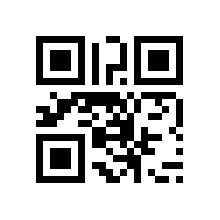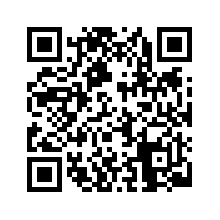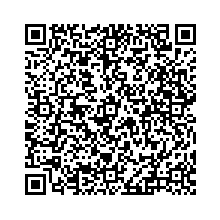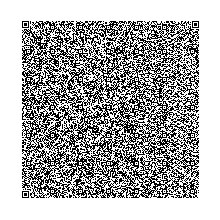QR code: Difference between revisions
BOT--Reverting link addition(s) by 98.23.36.238 to revision 453260713 (http://www.facebook.com/photo.php?fbid=267186446646500&set=a.252032984828513.67347.247177268647418&type=1&theater) |
|||
| Line 131: | Line 131: | ||
==External links== |
==External links== |
||
{{Commons category|Quick Response Codes}} |
{{Commons category|Quick Response Codes}} |
||
*[http://www.tekbuz.com/custom-qr-codes Custom QR Codes - Tekbuz.com] |
|||
*[http://www.denso-wave.com/qrcode/index-e.html QR Code - Official website] by QR Code's creator [[Denso|Denso-Wave]] |
*[http://www.denso-wave.com/qrcode/index-e.html QR Code - Official website] by QR Code's creator [[Denso|Denso-Wave]] |
||
<!-- Do NOT add links to external sites which generate QR Codes, or provide QR solutions. Wikipedia is not a directory of links. If you really believe you have something to link which is utterly unique, please bring it up on the discussion page. --> |
<!-- Do NOT add links to external sites which generate QR Codes, or provide QR solutions. Wikipedia is not a directory of links. If you really believe you have something to link which is utterly unique, please bring it up on the discussion page. --> |
||
Revision as of 20:38, 2 October 2011

A QR code (abbreviated from Quick Response code) is a type of matrix barcode (or two-dimensional code) first designed for the automotive industry. More recently, the system has become popular outside of the industry due to its fast readability and comparatively large storage capacity. The code consists of black modules arranged in a square pattern on a white background. The information encoded can be made up of any kind of data (e.g., binary, alphanumeric, or Kanji symbols)[1].
Created by Toyota subsidiary Denso Wave in 1994 to track vehicles during the manufacturing process[2], the QR code is one of the most popular types of two-dimensional barcodes. It was designed to allow its contents to be decoded at high speed.[3]
The technology has seen frequent use in Japan; the United Kingdom is the seventh-largest national consumer of QR codes.Cite error: The <ref> tag has too many names (see the help page).
Overview
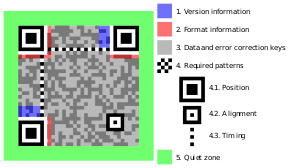
Although initially used to track parts in vehicle manufacturing, QR codes are now (as of 2011[update]) used over a much wider range of applications, including commercial tracking, entertainment and transport ticketing, product marketing and in-store product labeling. Many of these applications target mobile-phone users (via mobile tagging). Users may receive text, add a vCard contact to their device, open a Uniform Resource Identifier (URI), or compose an e-mail or text message after scanning QR codes. They can generate and print their own QR codes for others to scan and use by visiting one of several pay or free QR code-generating sites or apps. Google has a popular API to generate QR codes,[4] and apps for scanning QR codes can be found on nearly all smartphone devices.[5]
QR codes storing addresses and Uniform Resource Locators (URLs) may appear in magazines, on signs, on buses, on business cards, or on almost any object about which users might need information. Users with a camera phone equipped with the correct reader application can scan the image of the QR code to display text, contact information, connect to a wireless network, or open a web page in the telephone's browser. This act of linking from physical world objects is termed hardlinking or object hyperlinking.
QR codes can be used in Google's mobile Android operating system via both their own Google Goggles application or 3rd party barcode scanners like ZXing or Kaywa. The browser supports URI redirection, which allows QR codes to send metadata to existing applications on the device. Nokia's Symbian operating system features a barcode scanner which can read QR codes,[6] while mbarcode[7] is a QR code reader for the Maemo operating system. In the Apple iOS, a QR code reader is not natively included, but more than fifty paid and free apps are available with both scanning capabilities and hard-linking to URI. With BlackBerry devices, the App World application can natively scan QR codes and load any recognized Web URLs on the device's Web browser. Windows Phone 7.5 is able to scan QR codes through the Bing search app.
In the USA, QR code usage is expanding.[citation needed] During the month of June 2011, according to one study, 14 million mobile users scanned a QR code or a barcode. Some 58% of those users scanned a QR or bar code from their home, while 39% scanned from retail stores; 53% of the 14 million users were men between the ages of 18 and 34.[8]
Standards
There are several standards in documents covering the physical encoding of QR codes:[9]
- October 1997 — AIM (Association for Automatic Identification and Mobility) International[10]
- January 1999 — JIS X 0510
- June 2000 — ISO/IEC 18004:2000 Information technology — Automatic identification and data capture techniques — Bar code symbology — QR code (now withdrawn)
Defines QR code models 1 and 2 symbols. - September 1, 2006 — ISO/IEC 18004:2006 Information technology — Automatic identification and data capture techniques — QR code 2005 bar code symbology specification
Defines QR code 2005 symbols, an extension of QR code model 2. Does not specify how to read QR code model 1 symbols, or require this for compliance.
At the application layer, there is some variation between implementations. NTT DoCoMo has established de facto standards for the encoding of URLs, contact information, and several other data types.[11] The open-source "ZXing" project maintains a list of QR code data types.[12]
License
The use of QR codes is free of any license. The QR code is clearly defined and published as an ISO standard. Denso Wave owns the patent rights on QR codes, but has chosen not to exercise them.[9]
In the USA, the granted QR code patent is US5726435. In Japan it is JP2938338. In Germany it is DE69518098 (the European Patent Office granted patent EP0672994 to Denso Wave, but Denso only "nationalized" the patent grant in Germany).
The term QR code itself is a registered trademark of Denso Wave Incorporated.[13]
Storage
Data capacity
The amount of data that can be stored in the QR code depends on the character set, version and error correction level. The maximum values for version 40 with error correction capacity level L:[3][14]
| Numeric only | Max. 7,089 characters |
| Alphanumeric | Max. 4,296 characters |
| Binary (8 bits) | Max. 2,953 bytes |
| Kanji/Kana | Max. 1,817 characters |
-
Version 1, 21x21, 10-25 alphanumeric chars
-
Version 2, 25x25, 20-47 alphanumeric chars
-
Version 3, 29x29, 35-77 alphanumeric chars
-
Version 4, 33x33, 50-114 alphanumeric chars
-
Version 10, 57x57, 174-395 alphanumeric chars
-
Version 40, 177x177, 1,852-4,296 alphanumeric chars
Error correction
Codewords are 8 bits long and use the Reed–Solomon error correction algorithm with four error correction levels. The higher the error correction level, the less storage capacity.
While the exact number of errors that can be corrected depends on the size of the symbol and the location of the errors, the following table lists the approximate error correction capability at each of the four levels:
| Level L | 7% of codewords can be restored. |
| Level M | 15% of codewords can be restored. |
| Level Q | 25% of codewords can be restored. |
| Level H | 30% of codewords can be restored. |
Artistic QR codes

At the highest error correction level it is possible to create artistic QR codes that still scan correctly, but contain intentional errors to make them more readable or attractive to the human eye, as well as to incorporate colors, logos and other features into the QR code block.[15][16]
Variants

Micro QR code is a smaller version of the QR code standard for applications with less ability to handle large scans. There are different forms of Micro QR codes as well. The highest of these can hold 35 numeric characters.
Standard QR code is the QR code standard for applications that possess the ability to handle large scans. A standard QR code can contain up to 7089 characters, though not all QR readers can accept that much data.
Encryption
Although encrypted QR codes are not very common, there are a few implementations. An Android app,[17] for example, manages encryption and decryption of QR codes using a secure AES 128 algorithm.[18]
SKS
A special form of secure quick response codes utilizing public key encryption are SKS codes[citation needed] which are identical in appearance to normal QR codes. SKS codes were designed for one-time use and are created by encrypting a precursor hardware security token such as the CID[clarification needed] written in the ROM of a microSD card, applying a time stamp and displaying the code on, for example, the high resolution screen of a mobile handset. SKS codes are closely analogous[citation needed] to One-time pads, which are highly secure and can therefore be used for applications demanding high security such as mobile financial transactions. SKS codes in fact combine the CID and GMT[clarification needed] with other proprietary data related to the transaction, an assembly of datum which never occurs again and which is discarded after being decrypted and processed on the transaction server.[dubious – discuss] SKS codes were first developed in 2010 by the Japanese company Yodo KK and the patent is pending.[citation needed]
Stand-alone applications
While the adoption of QR codes in some markets has been slow to begin (particularly in markets such as the United States, where competing standards such as Data Matrix exist), the technology is gaining some traction in the smartphone market. Many Android, Nokia, Blackberry handsets, and the Nintendo 3DS, come with QR code readers installed. QR reader software is available for most mobile platforms. Moreover, there are a number of online QR code generators which enable users to create QR codes for their own needs.
Risks
Malicious QR codes combined with a permissive reader can put a computer's contents and user's privacy at risk. QR codes intentionally obscure and compress their contents and intent to humans.[19] They are easily created and may be affixed over legitimate QR codes.[20] On a smartphone, the reader's many permissions may allow use of the camera, full internet access, read/write contact data, GPS, read browser history, read/write local storage, and global system changes.[21][22][23]
Risks include linking to dangerous websites with browser exploits, enabling the microphone/camera/GPS and then streaming those feeds to a remote server, exfiltrating sensitive data (passwords, files, contacts, transactions),[24] and sending email/SMS/IM messages or DDOS packets as part of a botnet, corrupting privacy settings, stealing identity,[25] and even containing malicious logic themselves such as JavaScript[26] or a virus.[27][28] These actions may occur in the background while the user only sees the reader opening a harmless webpage. [29]
See also
References
- ^ QR Code features | QR Code.com Denso-Wave. Retrieved 9 September 2011.
- ^ Davis, Phillip (September 21, 2011). "How to Reach Your Mobile Customer Using QR Codes". SocialMediaToday.com. Retrieved September 21, 2011.
- ^ a b About 2D Code | QR Code.com Denso-Wave. Retrieved 23 April 2009.
- ^ "Google Chart Tools".
- ^ "QR Code Readers for iPhone, Android, Blackberry and Windows Phone 7".
- ^ "Nokia Europe - Nokia N80 - Support".
- ^ "package overview for mbarcode". Maemo.org. Retrieved 28 July 2010.
- ^ August 16, 2011 http://www.internetretailing.net/2011/08/14m-americans-scanned-qr-and-bar-codes-with-their-mobiles-in-june-2011/
- ^ a b "QR Code Standardization". QR Code.com. Denso-wave.com. Retrieved 23 April 2009.
- ^ "AIM Global Online Store". Aimglobal.org. Retrieved 23 April 2009.
- ^ "Synchronization with Native Applications". NTT DoCoMo. Retrieved 17 February 2009.
- ^ "Barcode Contents". zxing – A rough guide to standard encoding of information in barcodes. Retrieved 17 February 2009.
- ^ "QR Code.com". Denso-wave.com. 6 November 2003. Retrieved 23 April 2009.
- ^ "Version and Maximum capacity table". Denso-Wave.
- ^ Orli Sharaby (2010-10-18). "Form Meets Function: Extreme Makeover QR Code Edition". Retrieved 2011-07-29.
- ^ Hamilton Chan (2011-04-18). "HOW TO: Make Your QR Codes More Beautiful". Retrieved 2011-07-29.
- ^ "QR Droid". Google. 19 Aug 11. Retrieved 05 Sep 11.
{{cite web}}: Check date values in:|accessdate=and|date=(help) - ^ "Encrypted QR codes". QR Droid. 13 Jul 11. Retrieved 05 Sep 11.
{{cite web}}: Check date values in:|accessdate=and|date=(help) - ^ "A QR Code tells a much bigger story than a barcode". Troy Media. 21 Jun 11. Retrieved 31 Aug 11.
{{cite web}}: Check date values in:|accessdate=and|date=(help) - ^ "Malicious Images: What's a QR Code". SANS Technology Institute. 3 Aug 11. Retrieved 31 Aug 11.
{{cite web}}: Check date values in:|accessdate=and|date=(help) - ^ "Barcode Scanner". Google. 1 Jun 11. Retrieved 31 Aug 11.
{{cite web}}: Check date values in:|accessdate=and|date=(help) - ^ "QR Droid". Google. 19 Aug 11. Retrieved 31 Aug 11.
{{cite web}}: Check date values in:|accessdate=and|date=(help) - ^ "ScanLife Barcode Reader". Google. 24 May 11. Retrieved 31 Aug 11.
{{cite web}}: Check date values in:|accessdate=and|date=(help) - ^ "Consumer Alert: QR Code Safety". Better Business Bureau. 23 Jun 11. Retrieved 31 Aug 11.
{{cite web}}: Check date values in:|accessdate=and|date=(help) - ^ "AVG Cautions: Beware of Malicious QR Codes". PC World. 28 Jun 11. Retrieved 31 Aug 11.
{{cite web}}: Check date values in:|accessdate=and|date=(help) - ^ "EvilQR – When QRCode goes bad". AppSec-Labs Blog. 14 Aug 11. Retrieved 31 Aug 11.
{{cite web}}: Check date values in:|accessdate=and|date=(help) - ^ "QR Codes: A Recipe for a Mobile Malware Tsunami". Cyveillance, Inc. 20 Oct 10. Retrieved 31 Aug 11.
{{cite web}}: Check date values in:|accessdate=and|date=(help) - ^ QR Codes hold up to 2.9 KB whereas the smallest known computer virus is about one-tenth that size "The Smallest Virus I Could Manage". Virus Labs and Distribution. 1995. Retrieved 31 Aug 11.
{{cite web}}: Check date values in:|accessdate=(help) - ^ "Beware of Malicious QR Codes". ABC. 8 Jun 11. Retrieved 31 Aug 11.
{{cite web}}: Check date values in:|accessdate=and|date=(help)
Bibliography
- BS ISO/IEC 18004:2006. Information technology. Automatic identification and data capture techniques. Bar code symbology. QR code. Geneva: ISO/IEC. 2000. p. 114. at OCLC
- BS ISO/IEC 18004:2006. Information technology. Automatic identification and data capture techniques. QR Code 2005 bar code symbology specification. London: BSI. 2007. p. 126. ISBN 978-0-580-67368-9.
External links
- Custom QR Codes - Tekbuz.com
- QR Code - Official website by QR Code's creator Denso-Wave
- Generate QR code for this page

